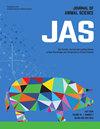摘要
选取 44 头怀孕的安格斯头胎小母牛(初始体重 [BW] = 490 ± 8 千克,体况评分 [BCS] = 5.4 ± 0.06),在其妊娠期后三个月结束时将其分配到实验中。从第 0 天起至产犊前,收集头胎小母牛,每周三次单独饲喂干蒸馏谷物(DDG;每头小母牛每次饲喂 3.5 千克;按饲喂量计算)+处理。处理为1)基于二十碳五烯酸(EPA)和二十二碳六烯酸(DHA)的多烯脂肪酸钙盐(OMG,Strata;Virtus Nutrition LLC,Corcoran,CA;n = 22),每头小母牛每次饲喂 234 克;或 2)基于棕榈酸和油酸的饱和及单不饱和脂肪酸钙盐(CON;EnerGII,Virtus Nutrition;n = 22),每头小母牛每次饲喂 234 克。从第 -11 天(妊娠期 192 ± 5.1 天)到产仔,小母牛被分配到牧场放牧。记录头胎小母牛的体重和BCS(第-10天和第-9天),并在第-10天和产犊时采血。犊牛在第 260 天断奶,第 260 天至第 302 天进行预处理,第 303 天至第 350 天进行饲喂。产犊时母牛体重或 BCS 变化无差异(P ≥ 0.33)。在补充 OMG 的小母牛与补充 CON 的小母牛中,观察到初乳 IgG 浓度更高的趋势(P = 0.08)。在产犊时,各处理之间在产犊率、出生体重、心周长和出生公犊百分比方面没有差异(P ≥ 0.31)。与 CON 小牛相比,OMG 小牛的血浆 IgG 浓度更高(P = 0.04)。在断奶率和断奶日龄、出生至断奶日增重、断奶体重、肝酶和血清呼吸道病毒抗体方面未观察到差异(P ≥ 0.11)。在预处理期间,与 CON 母牛所产犊牛相比,OMG 母牛所产犊牛的最终体重和日增重更大(P ≤ 0.05)。这些性能差异在整个接收阶段都保持不变(P ≤ 0.05)。在血浆皮质醇浓度方面,发现了处理×日的交互作用(P = 0.05),与CON组群相比,OMG头胎母牛所产犊牛在第260天和263天的皮质醇浓度更高(P < 0.01),在第306天的皮质醇浓度更低(P < 0.01)。给晚期妊娠的头胎小母牛补充欧米伽-3 脂肪酸可提高小母牛及其后代的 IgG 浓度。虽然后代从出生到断奶期间的生长未受影响,但 OMG 小牛在预处理和接收阶段的体重有所增加,这表明其在长期生长方面具有潜在益处。Forty-four pregnant Angus first-calf heifers (initial body weight [BW] = 490 ± 8 kg, body condition score [BCS] = 5.4 ± 0.06) were selected and assigned to the experiment at the end of their second trimester of gestation. From d 0 until calving, first-calf heifers were gathered and individually fed three times a week with dry distillers' grain (DDG; 3.5 kg/heifer per feeding; as-fed basis) + treatments. Treatments were: 1) 234 g/heifer per feeding of Ca salts of PUFA based on eicosapentaenoic (EPA) and docosahexaenoic (DHA) acids (OMG, Strata; Virtus Nutrition LLC, Corcoran, CA; n = 22), or 2) 234 g/heifer per feeding of Ca salts of saturated and monosaturated fatty acids based on palmitic and oleic acids (CON; EnerGII, Virtus Nutrition; n = 22). From d -11 (d of gestation 192 ± 5.1) to calving, heifers were allocated to rangeland pasture. First-calf heifer BW and BCS were recorded (d -10 and -9), and blood was collected on d -10, and upon calving. Calves were weaned on d 260, and preconditioned from d 260 to 302, and feedlot received from d 303 to 350. No differences were detected (P ≥ 0.33) for heifer BW or BCS changes at calving. A tendency for greater concentration of colostrum IgG (P = 0.08) was observed in heifers supplemented with OMG vs. CON cohorts. There were no differences (P ≥ 0.31) among treatments at calving for calving rate, birth BW, heart girth, and % of male calves born. Calves from OMG heifers had greater (P = 0.04) plasma IgG concentration compared to CON calves. No differences were observed (P ≥ 0.11) for weaning rate and age, birth to weaning ADG, weaning weight, liver enzymes, and serum antibodies against respiratory viruses. During the preconditioning, OMG calves had greater (P ≤ 0.05) final BW and ADG compared with calves born to CON heifers. These differences in performance remained (P ≤ 0.05) throughout the receiving phase. A treatment × day interaction was detected (P = 0.05) for plasma cortisol concentration, which was greater (P < 0.01) for calves born to OMG first-calf heifers on d 260 and 263 and lower (P < 0.01) on d 306 compared to CON cohorts. Supplementing omega-3 fatty acids to late-gestating first-calf beef heifers enhances IgG concentrations in both heifers and their offspring. While offspring growth from birth to weaning remained unaffected, OMG calves demonstrated increased weight during the preconditioning and receiving phases, suggesting potential long-term growth benefits.

 求助内容:
求助内容: 应助结果提醒方式:
应助结果提醒方式:


